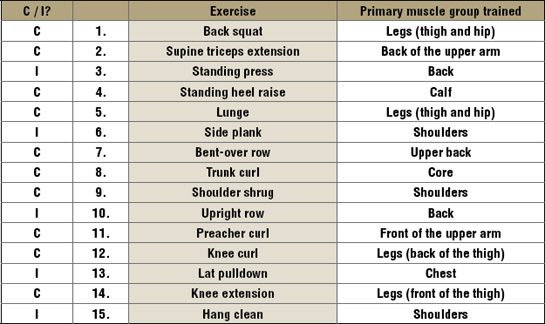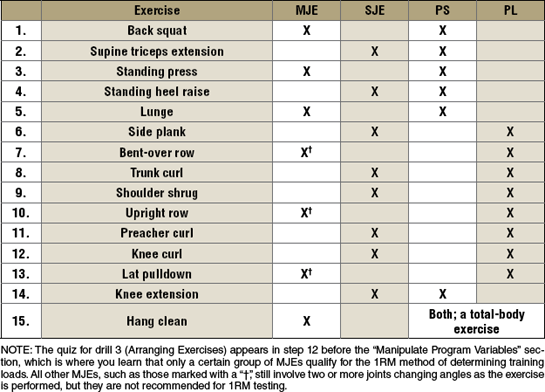
1. b
2. b
3. c
4. c
5. b
6. b
7. a

1. I; Knee extension—Knee curl
2. C
3. I; Dumbbell chest fly—Bent-over row (or Machine row or Seated row)

1. 1-repetition maximum
2. lunge
3. 20
1. completing 2 or more repetitions above the goal in the last set in two consecutive workouts
2. heavier
1. fewer
2. load
1. 2
2. recruit
1. more
2. an effect
1a. light
1b. 60-67%
1c. 12-20
1d. 2-3
2. 20 to 30 seconds
1a. moderate
1b. 67-85%
1c. 6-12
1d. 3-6
1e. 30-90 seconds
2. superset
1a. heavy
1b. 85-100%
1c. 1-6
1d. 3-5
1e. 2-5 minutes
2. 170 pounds (77.3 kg)
3. progressive overload principle
4. pyramid; multiple set–same load
5. SJEs

1. on a regular basis
2. fewer
3. less
4. split
1. recover from the overloading
2. as many repetitions as possible
3. loads and sets
The load that should be lifted to perform as many repetitions as possible is 150 pounds (68.2 kg). Using table 12.4, we find that the repetition factor for 8 repetitions is 1.27. We multiply 150 pounds by 1.27 to get 190.5 pounds (86.6 kg). On table 13.7, 190 pounds is on line 35. Line 35 intersects with the 75 percent column at 143. Rounded down, this number equals a training load of 140 pounds (63.6 kg).
The load used is 105 pounds (47.7 kg), with gives us a repetition factor of 1.16 for 5 repetitions, according to table 12.4. If we multiply 105 pounds by 1.16, we get 121.8 pounds (55.4 kg), which rounds to 120 pounds (54.5 kg) as the predicted 1RM. We find 120 pounds on line 21 in table 13.7. For a training load of 80 percent, find the number at the junction of line 21 and 80 percent in table 13.7 (96, rounded down to 95 [43.2 kg]). For a training load of 67 percent, find the number at the junction of line 21 and 67 percent in table 13.7 (80 pounds [36.4 kg]). For a training load of 75 percent, find the number at the junction of line 21 and 75 percent in table 13.7 (90 pounds [40.9 kg]).
